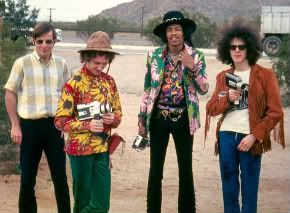 What do Jeff Beck, Jimmy Page and submarine warfare have in common? A stomp box maker by the name of Roger Mayer.
What do Jeff Beck, Jimmy Page and submarine warfare have in common? A stomp box maker by the name of Roger Mayer.
A hometown buddy of both Beck and Page—not to mention, a fell guitar enthusiast and tone freak—Mayer had the heavy-duty day job of performing acoustical and vibration analyses for Royal Navy Scientific Service. His career got a boost in 1964 when Page, then an up-and-coming session guitarist, brought the electronics whiz a copy of the Ventures’ surf-fuzz hit song “The 2,000 Pound Bee.” Could Mayer create a pedal that emulated the song’s distorted tones? asked Page. Indeed he could.
“The first pedals that I made for Page and Beck ran off a six-volt battery and were housed in a custom-made casing,: says Mayer. “There were controls for gain and biasing as well as a switch that modified the tonal output. They were rather unlike the pedals that you see today in that they had a separate footswitch attached to the box by a length of cable.”
Like other fuzz units of the day, Mayer’s employed germanium transistors. Sensitive to heat, and unpredictable, they were the only variety of transistor publicly available at the time. “I was already using silicon transistors in my work with the government,” says Mayer, “but they cost the equivalent of a week’s wages.” Not that germanium transistors were cheap. “One of those—and that was just one of the components of the boxes—would cost around one-tenth of what the average person earned in a week,” he says.
————————————————————
Given such prohibitive expenses (Mayer says he didn’t charge Beck or Page), the novice pedal maker produced very few units, and those lucky enough to own one were in an enviable position. Other fuzz units were available, such as Maestro’s Fuzz-Tone—Keith Richards put one to extremely good use on the Rolling Stones’ “(I Can’t Get No) Satisfaction”—but Mayer’s design differed significantly from the competition’s.
“The Maestro Fuzz-Tone was basically just and overdriven transistor amplifier using a rather standard, textbook circuit,” he says. “They made a particularly raspy, tinny kind of noise, with a very high density of odd-order harmonics.
“That sound may have its place in music, but I personally don’t like it. It doesn’t emulate the sound of a saxophone or any other instrument, and I’ve always been interested in making boxes that produce more even harmonics, because they’re more musical—more in keeping with the nature of the sound. I found that if I rolled off some of the high end from the guitar’s signal before distorting it, and them added some highs back in afterwards, it made the distortion much, much smoother.”
In 1966, Mayer hooked up with a promising young guitarist named Jimi Hendrix, who was enthralled by the pedal designer’s new Octavia effect. “Jimi was a total tone freak,” recalls Mayer. “That’s all we ever talked about.” Which both Beck and Page maintain Mayer abandoned them once he began working for Hendrix, he flatly denies the allegations. “I think Jimmy and Jeff got intimidated when I met Hendrix and started working with him,” says Mayer, laughing. “They didn’t call me up after that. They could have had anything they wanted had they bothered to ask me!”
Mayer continued to work with Hendrix until the guitarist’s death in 1970. Afterward, he turned his designing skills to recording equipment, and in 1980 began commercial production of his owl line of effects pedals (https://www.roger-mayer.co.uk/). “All my boxes are built on the same principles as my early units,” says Mayer. “If you want to design a box that sounds musical, there’s one cardinal rule you always need to observe: it’s got to follow the laws of nature.”
Gear-Vault Classifieds is an eBay alternative. Come sell your used guitars and amps with us, for FREE!





Be the first to comment